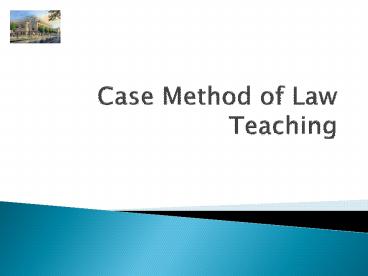Case Method of Law Teaching - PowerPoint PPT Presentation
1 / 20
Title:
Case Method of Law Teaching
Description:
Case Method of Law Teaching Case Method A system of instruction or study of law focused upon the analysis of court opinions rather than lectures and textbooks; the ... – PowerPoint PPT presentation
Number of Views:301
Avg rating:3.0/5.0
Title: Case Method of Law Teaching
1
Case Method of Law Teaching
2
Case Method
- A system of instruction or study of law focused
upon the analysis of court opinions rather than
lectures and textbooks the predominant method of
teaching in U.S. law schools today.
3
Professor Langdell
- CHRISTOPHER COLUMBUS LANGDELL, a law professor,
often receives credit for inventing the case
method although historians have found evidence
that others were teaching by this method before
him. Regardless, Langdell by all accounts
popularized the case method.
4
History
- Langdell introduced the method around1870 at
Harvard Law School - Langdell viewed the law as a science and believed
that it should be studied as a science - Law consists of certain principles or doctrines.
To have such a mastery of these as to be able to
apply them with constant facility and certainty
to the ever-tangled skein of human affairs, is
what constitutes a true lawyer and hence to
acquire that mastery should be the business of
every earnest student of law.
5
The lecture method
- Throughout the 1800s, the prevalent approach for
teaching law school classes was the lecture
method. Although professors and textbooks
interpreted the meaning of various court
decisions, they did not offer a significant
opportunity for students to do so on their own.
6
Changes
- The case method, on the other hand, forced
students to read, analyze, and interpret cases
themselves. It was Langdell's opinion that law
students would be better educated if they were
asked to reach their own conclusions about the
meaning of judicial decisions.
7
Reactions to the case method
- Langdell's ideas were, at first, overwhelmingly
rejected by students, other law professors, and
attorneys alike. These critics viewed the case
method as chaotic compared with organized
lectures. They believed that instead of
soliciting law students' opinions regarding
cases, professors should simply state their own
interpretations.
8
Reactions of students
- Law students, afraid that they were not learning
from Langdell's method, dropped out of his class,
leaving him with only a few pupils. Enrollment in
the Harvard Law School decreased dramatically
because of concern over Langdell's case method
and alumni called for his dismissal.
9
Langdells success
- The president of Harvard University, Charles W.
Eliot, supported Langdell and his case method.
This backing allowed Langdell to withstand the
criticism long enough to prove the case method's
success Langdell's students were becoming
capable, skilled attorneys.
10
Adoption of the Case Method
- In 1870 Langdell became law school dean. As time
passed he replaced his critics on the Harvard
faculty with professors who believed in his
system of teaching and the case method soon
became the dominant teaching method at Harvard.
Other U.S. law schools took note.
11
Primary method
- By the early 1900s, most US law schools had
adopted the case method, and it remained the
primary method of legal instruction throughout
the twentieth century and beyond.
12
Video explanation
- http//www.youtube.com/watch?vEwPOVyvGvo8
- Explain Langdells reasons for advocating the
case method of law teaching!
13
Characteristics of the Case Method
- Socratic methodThe case method is usually
coupled with a type of classroom teaching called
the Socratic method. Through the Socratic method
students orally respond to an often difficult
series of questions designed to help them gain
further insight into the meaning of the law. - Professors question students on the actual cases
assigned for a particular class - Students challenge unquestioned assumptions and
reveal underlying legal principles
14
Prerequisites
- Lecturer as a facilitator
- The dialogue form of teaching
- Active participation in the class
15
Sudents tasks
- Review the background information and the facts
in the case - Determine the main issue in the case
- Examine alternative arguments on the issue in the
case - Consider the decision and legal reasoning in the
case - Assess the implications and the significance of
the case in constitutional history
16
What it looks like...
- http//www.youtube.com/watch?viaQbC5bgh2s
17
Advantages of the method
- It stimulates active involvement of students and
prepares them for adversarial debates and quick
retorts required by practicing lawyers - Students learn the skill of critical analysis
this way they learn to discern relevant from
irrelevant facts they learn to distinguish
between seemingly similar facts and issues and
they learn to analogize between dissimilar facts
and issues.
18
Cricticism of the method
- Critics argue that the case method fails to
impart moral values, causes unnecessary and
harmful stress, fosters incivility and overly
competitive attitudes and leaves students
unprepared for the realities of practice
19
Thoughtsopinions
- What do you think about the case method?
- Would you like to participate in the classes
featuring this method? - Do you believe it causes additional stress?
20
Thank you for your attention!































